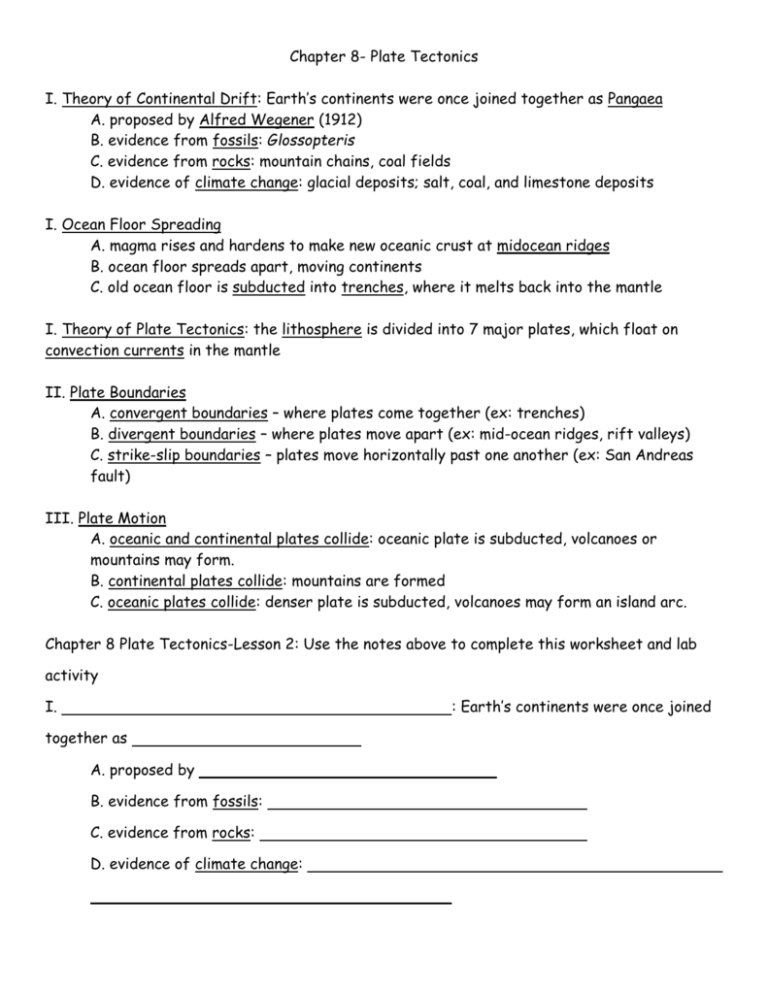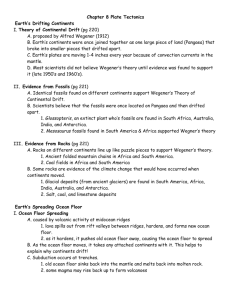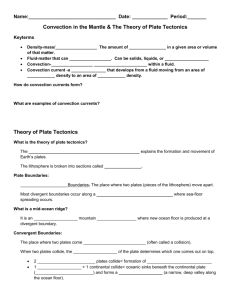Chapter 3 Plate Tectonics - Hamilton Township Schools
advertisement

Chapter 8- Plate Tectonics I. Theory of Continental Drift: Earth’s continents were once joined together as Pangaea A. proposed by Alfred Wegener (1912) B. evidence from fossils: Glossopteris C. evidence from rocks: mountain chains, coal fields D. evidence of climate change: glacial deposits; salt, coal, and limestone deposits I. Ocean Floor Spreading A. magma rises and hardens to make new oceanic crust at midocean ridges B. ocean floor spreads apart, moving continents C. old ocean floor is subducted into trenches, where it melts back into the mantle I. Theory of Plate Tectonics: the lithosphere is divided into 7 major plates, which float on convection currents in the mantle II. Plate Boundaries A. convergent boundaries – where plates come together (ex: trenches) B. divergent boundaries – where plates move apart (ex: mid-ocean ridges, rift valleys) C. strike-slip boundaries – plates move horizontally past one another (ex: San Andreas fault) III. Plate Motion A. oceanic and continental plates collide: oceanic plate is subducted, volcanoes or mountains may form. B. continental plates collide: mountains are formed C. oceanic plates collide: denser plate is subducted, volcanoes may form an island arc. Chapter 8 Plate Tectonics-Lesson 2: Use the notes above to complete this worksheet and lab activity I. : Earth’s continents were once joined together as A. proposed by B. evidence from fossils: C. evidence from rocks: D. evidence of climate change: I. A. magma rises and hardens to make new oceanic crust at B. ocean floor C. , moving continents pushes old ocean floor back into the at I. Theory of Plate Tectonics: the lithosphere is divided into 7 major plates, which float on convection currents in the mantle II. Plate Boundaries A. convergent boundaries – where plates come together (ex: trenches) B. divergent boundaries – where plates move apart (ex: mid-ocean ridges, rift valleys) C. strike-slip boundaries – plates move horizontally past one another (ex: San Andreas fault) III. Plate Motion A. oceanic and continental plates collide: B. continental plates collide: C. oceanic plates collide: Chapter 8 Plate Tectonics Earth’s Drifting Continents I. Theory of Continental Drift (pg 220) A. proposed by Alfred Wegener (1912) B. Earth’s continents were once joined together as one large piece of land (Pangaea) that broke into smaller pieces that drifted apart. C. Earth’s plates are moving 1-4 inches every year because of convection currents in the mantle. D. Most scientists did not believe Wegener’s theory until evidence was found to support it (late 1950’s and 1960’s). II. Evidence from Fossils (pg 221) A. Identical fossils found on different continents support Wegener’s Theory of Continental Drift. B. Scientists believe that the fossils were once located on Pangaea and then drifted apart. 1. Glossopteris, an extinct plant who’s fossils are found in South Africa, Australia, India, and Antarctica. 2. Mesosaurus fossils found in South America & Africa supported Wegner’s theory III. Evidence from Rocks (pg 221) A. Rocks on different continents line up like puzzle pieces to support Wegener’s theory. 1. Ancient folded mountain chains in Africa and South America. 2. Coal fields in Africa and South America B. Some rocks are evidence of the climate change that would have occurred when continents moved. 1. Glacial deposits (from ancient glaciers) are found in South America, Africa, India, Australia, and Antarctica. 2. Salt, coal, and limestone deposits Earth’s Spreading Ocean Floor I. Ocean Floor Spreading A. caused by volcanic activity at midocean ridges 1. lava spills out from rift valleys between ridges, hardens, and forms new ocean floor. 2. as it hardens, it pushes old ocean floor away, causing the ocean floor to spread B. As the ocean floor moves, it takes any attached continents with it. This helps to explain why continents drift! C. Subduction occurs at trenches. 1. old ocean floor sinks back into the mantle and melts back into molten rock. 2. some magma may rise back up to form volcanoes Earth’s Moving Plates I. Theory of Plate Tectonics (pg 224-225) A. combines theories of continental drift and ocean floor spreading to explain how the Earth has changed over time II. Lithospheric Plates (pg 224 ) A. usually contain both oceanic and continental crust B. 7 major plates: Pacific plate is the largest III. Plate Boundaries (pg 225) A. most plate boundaries are on the ocean floor B. divergent boundaries – where plates move apart (mid-ocean ridges) C. convergent boundaries – where plates come together (trenches) 1. earthquakes and volcanoes occur D. strike-slip boundaries – plates move horizontally past one another 1. formed by lateral faults (strike-slip faults) 2. earthquakes often occur 3. ex. San Andreas fault in California IV. Plate Motion (pg 222) A. convection currents in the mantle cause the lithospheric plates to move at different speeds in different directions B. plates collide! 1. collision of oceanic and continental plates: oceanic plate is subducted, volcanoes and/or mountains may form. 2. collision of two continental plates: crust is pushed up to form mountains 3. collision of two oceanic plates: denser plate is subducted, volcanoes may form an island arc.








